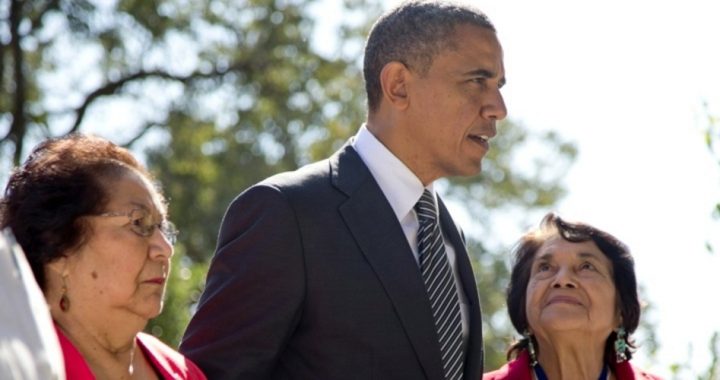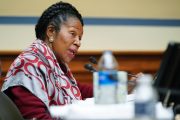
President Obama, during a campaign trip in California, designated the former home and headquarters of United Farm Workers labor activist César Chávez as a national monument on October 8. The site formally designated as the César E. Chávez National Monument sits on the 187-acre property in Keene, California, known as Nuestra Señora Reina de la Paz (Our Lady Queen of Peace), or simply La Paz. The monument encompasses 105 acres of the property and is the fourth site Obama has designated under the Antiquities Act, which gives the president authority, by executive order, to restrict the use of public land owned by the federal government.
A writer for Yahoo! News commented on the political ramifications of the dedication:
Obama’s move, with less than a month to go before Election Day, could have political repercussions: The Democrat is counting on Latino voters to rally behind him to defeat Mitt Romney. It could also burnish his credentials with labor and environmental groups that have not always been happy with the president.
An AP report in the Boston Globe observed:
The action could shore up support from some Hispanic and liberal voters for Obama, whose 2008 ‘‘yes we can’’ slogan borrowed from Chávez’s motto, ‘‘Si, se puede.’’
Obama both opened and closed his remarks at the dedication with the “¡Si, se puede!” slogan, and the audience responded enthusiastically in kind.
During his address, Obama recognized Dolores Huerta, who, along with Chávez, co-founded the National Farmworkers Association, which later became the United Farm Workers. The president stated:
César would be the first to say that this is not a monument to one man. The movement he helped to lead was sustained by a generation of organizers who stood up and spoke out, and urged others to do the same — including the great Dolores Huerta, who is here today.
In an article published online by The New American on May 31, “Obama Honors Top Socialist Dolores Huerta with Medal of Freedom,” Alex Newman identified the recipient of the prestigious award as “[an Obama] fellow ‘community organizer,’ collectivist, radical feminist, as well as the honorary chair of Democratic Socialists of America.”
Newman provided some interesting commentary about Huerta and her past, quoting from author and investigative reporter Matthew Vadum’s article about about the May 29 Medal of Freedom award in FrontPage magazine. “She is less the civil rights leader imagined by the mainstream media and more a champion of vulgar redistributionism,”wrote Vadum. “As the saying goes, if you give a man a fish, you feed him for a day, but if you teach a man to fish, you feed him for a lifetime. Community organizers like Huerta don’t teach anyone how to fish: they teach activists how to steal their neighbors’ fish. This is what Huerta and her ilk call social justice.”
Newman also noted that Obama acknowledged during the ceremony that he “stole” the “Yes We Can” campaign slogan from Huerta, saying: “Dolores was very gracious when I told her I had stolen her slogan, ‘Sí, se puede’ — Yes, we can.”
During that May White House ceremony, Huerta revealed that her political interests extended far beyond grape pickers. “The great social justice changes in our country have happened when people came together, organized, and took direct action,” she said. “The civil rights movement, the labor movement, the women’s movement, and the equality movement for our LGBT [lesbian, gay, bisexual, and transgender] brothers and sisters are all manifestations of these rights.”
The main focus at the October 8 event, however, was César Chávez. Though the labor leader (whom some also regard as a civil rights leader who saved impoverished agricultural workers from a Grapes of Wrath-type existence) has been lionized by the media as a folk hero of mythical proportions, the history of the United Farm Workers is not quite as stellar as is commonly portrayed. This popular view of Chávez was disputed in an exposé written by the late Gary Allen in American Opinion magazine (a predecessor to The New American) back in June 1966. In that article, “The Grapes: Communist Wrath in Delano,” Allen revealed that Chávez was recruited and hired in the early 1950s by a staff member for Saul Alinsky’s Industrial Areas Foundation, observing that “Chavez could have found no better training ground for revolution. His mentor Alinsky, describes himself as a ‘professional radical’ and is author of Reveille For Radicals and Rules For Revolution (to be published this year [1966]). He runs a prep school in grass-roots organizing for revolution based upon picketlines, boycotts, mass meetings, rent strikes. demonstrations, and sit-ins.”
Allen noted that Chávez “spent six years in Chicago studying at the ‘Alinsky School of Revolution’ before his ‘teachers’ thought he was ready to return to California to found the N.F.W.A.”
In the article, “Saul Alinsky: A Radical Who Matters,” by Gregory A. Hession, published online by The New American on October 28, 2008, the author traced Alinsky’s legacy of radical community organizing, noting:
After Alinsky’s death in 1972, many large new community-organizing networks developed using his methods. These include Alinsky’s own Industrial Areas Foundation (IAF), along with ACORN, Citizen Action, National People’s Action, PICO, DART, and the Gamaliel Foundation. IAF and its progeny have produced radical organizing luminaries such as César Chávez. Many of these groups have been instrumental in promoting Barack Obama’s presidential candidacy.
During his speech, Obama continued the romanticized saga of the labor activist who had learned his trade from the professional organizers at Saul Alinsky’s Industrial Areas Foundation:
But Cesar cared. And in his own peaceful, eloquent way, he made other people care, too. A march that started in Delano with a handful of activists — (applause) — that march ended 300 miles away in Sacramento with a crowd 10,000 strong. (Applause.) A boycott of table grapes that began in California eventually drew 17 million supporters across the country, forcing growers to agree to some of the first farm worker contracts in history. Where there had once been despair, Cesar gave workers a reason to hope.
Hope. Change. ‘‘Si, se puede.’’
President Barack Obama walks with César Chávez’s widow Helen F. Chávez, left, and Dolores Huerta, Co-Founder of the United Farm Workers, as they tour the César E. Chávez National Monument Memorial Garden, Oct. 8, 2012, in Keene, Calif.: AP Images



